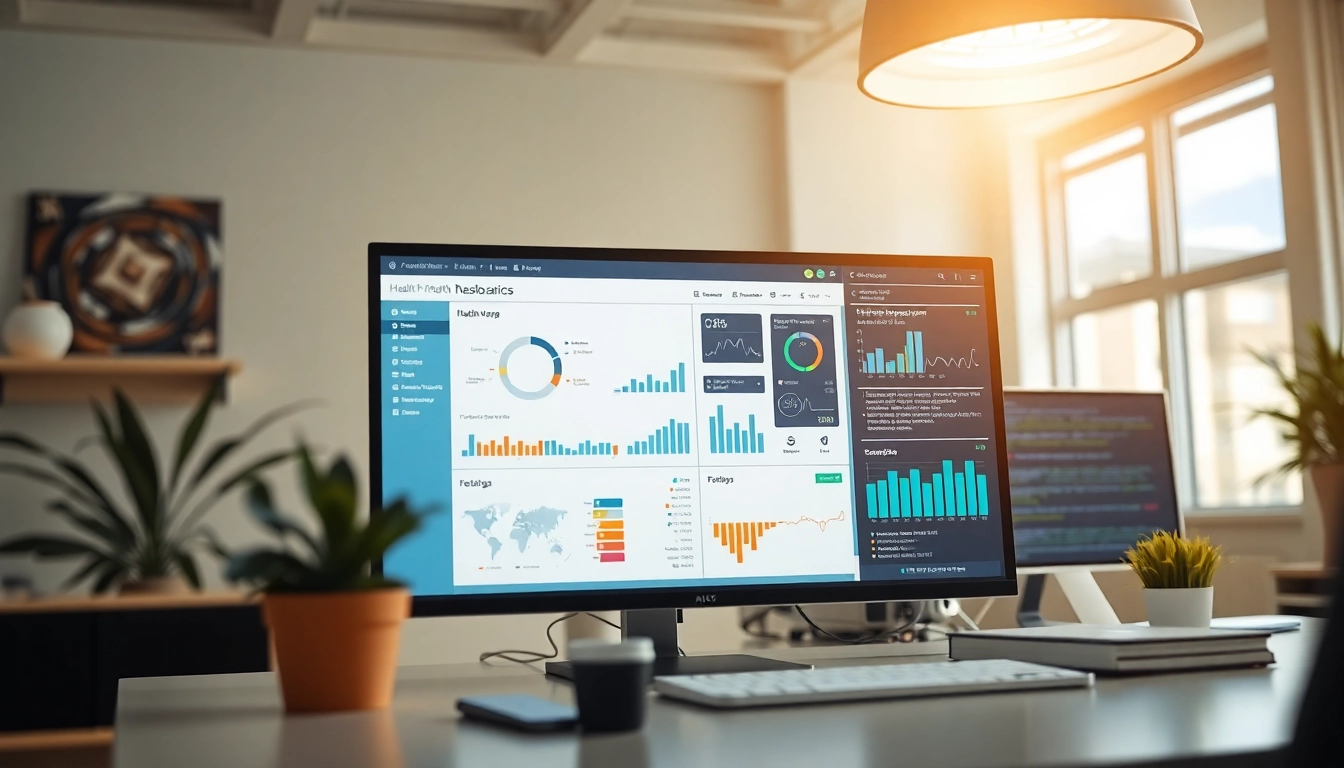Understanding the Basics of Health Informatics
Defining Health Informatics
Health informatics is an interdisciplinary field that combines health care, information technology (IT), and data management to enhance the quality and safety of patient care. It involves the use of advanced systems, software, and databases to collect, store, manage, and analyze health-related data. In essence, it is the science of transforming data and information into actionable knowledge that supports clinical decision-making and improves health outcomes.
As healthcare systems continue to evolve with increasing complexity and demands for improved patient care, health informatics plays a crucial role in streamlining processes and enabling meaningful use of data. It encompasses electronic health records (EHR), telemedicine, clinical decision support systems (CDSS), and public health informatics, among other applications.
Importance of Health Informatics
The significance of health informatics cannot be overstated. It serves as a backbone for modern healthcare delivery, contributing to improved patient outcomes, enhanced efficiency, and greater satisfaction for both patients and providers. Here are some key aspects that highlight its importance:
- Enhanced Patient Care: By integrating data from various sources, health informatics ensures that healthcare providers have access to critical patient information at the right time, leading to more accurate diagnoses and treatment plans.
- Cost Reduction: Streamlining processes through informatics reduces administrative burdens and errors, leading to lower operational costs in healthcare settings.
- Data-Driven Decision Making: Access to real-time data analytics empowers clinicians to make informed decisions, facilitating better patient management and population health strategies.
- Improved Collaboration: Health informatics fosters interoperability among different healthcare disciplines, promoting collaboration and communication among care teams.
Key Components of Health Informatics Systems
Health informatics systems are composed of several interrelated components that work together to manage health information effectively. These components include:
- Electronic Health Records (EHRs): Digital records that contain a patient’s medical history, treatments, medications, and allergies, facilitating seamless information exchange between healthcare providers.
- Clinical Decision Support Systems (CDSS): Tools that provide healthcare professionals with clinical knowledge and patient-specific information to assist in decision-making.
- Health Information Exchange (HIE): The electronic sharing of health-related information among organizations, improving care coordination and reducing duplicative tests.
- Telemedicine Platforms: Technology that enables remote consultations and monitoring, enhancing access to healthcare services.
Applications of Informatics in Healthcare
Electronic Health Records: A Case Study
The implementation of Electronic Health Records (EHRs) in healthcare facilities has markedly transformed patient care. A significant case study from a large healthcare system illustrates the impact of EHR adoption:
At www.informaticsview.com, a study demonstrated that after the implementation of EHRs, the facility experienced a 30% reduction in medication errors, primarily due to features like automated alerts and reminders. EHRs also improved inter-provider communication, allowing specialists to have comprehensive access to patient data without unnecessary delays.
This case underscores the potential of EHR systems to enhance safety and quality in healthcare environments.
Telemedicine and Remote Monitoring
Telemedicine has gained prominence, particularly in the wake of the COVID-19 pandemic, enabling remote consultations and monitoring capabilities. Health informatics facilitates these services through sophisticated platforms that provide virtual care. For instance:
A survey by the American Medical Association revealed that telemedicine usage surged by 154% in March 2020 compared to the previous year. This transition is attributed to the flexibility and accessibility of care through virtual visits, particularly for patients in rural areas lacking proximity to healthcare facilities.
Remote monitoring technologies further contribute by collecting patient data through wearable devices, ensuring continuous monitoring of chronic conditions like diabetes and hypertension. This integration not only enhances patient engagement but also allows for proactive interventions by healthcare providers.
Clinical Decision Support Systems Explained
Clinical Decision Support Systems (CDSS) are vital tools that help clinicians make data-informed decisions. These systems analyze health data and provide recommendations or alerts to optimize patient care. There are two primary types of CDSS:
- Knowledge-Based Systems: These systems use existing medical knowledge, guidelines, and clinical protocols to suggest best practices and alert clinicians about potential issues.
- Non-Knowledge-Based Systems: These systems leverage machine learning algorithms to identify patterns and trends from large datasets, learning to provide recommendations over time.
For example, a CDSS may alert a physician about possible drug interactions based on the patient’s current medications, ensuring patient safety and adherence to clinical guidelines.
Technology Innovations Driving Informatics
Big Data Analytics in Patient Care
The growth of big data analytics has profound implications for health informatics. By harnessing vast amounts of health data—from EHRs, claims data, and patient-generated data—healthcare providers can gain insights that drive improvements in care delivery:
For instance, hospitals utilizing big data analytics successfully predicted adverse patient outcomes by analyzing historic data trends, leading to proactive interventions that significantly decreased readmission rates.
Moreover, big data facilitates population health management by identifying at-risk groups and tailoring preventive measures. Predictive analytics can help in resource allocation and planning, ultimately improving the overall efficiency of healthcare systems.
Artificial Intelligence in Healthcare
Artificial Intelligence (AI) has emerged as a game-changer in health informatics, enabling advanced data analysis and automating repetitive tasks. AI applications in healthcare include:
- Diagnostic Imaging: AI algorithms analyze medical images to detect conditions such as tumors more accurately and quickly than traditional methods.
- Natural Language Processing (NLP): NLP helps extract pertinent information from unstructured data sources such as clinical notes, improving data usability for research and decision-making.
- Personalized Medicine: AI systems analyze genetic and clinical data to tailor treatments specific to individual patient profiles.
These innovations not only improve diagnostic accuracy but also enhance the overall patient experience by reducing wait times and streamlining treatment plans.
Interoperability Challenges and Solutions
Despite the advancements in health informatics, interoperability remains a significant challenge. The ability of various health IT systems and software applications to communicate and exchange data is critical for seamless patient care. Current interoperability issues include:
- Data Silos: Different systems often store data in incompatible formats, limiting information sharing.
- Standardization: Lack of universal standards for data formats and terminologies can hinder the exchange of information.
Solutions to improve interoperability involve the adoption of standardized protocols such as HL7 FHIR (Fast Healthcare Interoperability Resources), which facilitate smoother data exchange and integration across different systems.
Future Trends in Health Informatics
Emerging Technologies Impacting Healthcare
The landscape of health informatics continues to evolve, driven by emerging technologies that promise to enhance patient care further. Key trends to watch include:
- Blockchain Technology: Utilizing blockchain can enhance data security and integrity, providing an immutable ledger for patient records.
- Virtual Reality and Augmented Reality: These technologies hold potential in areas such as medical training, patient therapy, and surgical planning by providing immersive simulations.
- Internet of Things (IoT): Connected devices will enable real-time health monitoring and data collection, enhancing proactive care.
Policy Changes and Their Implications
As health informatics evolves, so do the policies that govern its implementation and use. Recent policy changes, such as those advocating for enhanced data sharing and patient privacy protections, have significant implications for healthcare providers:
Healthcare organizations must stay apprised of standards from regulatory bodies to ensure compliance while maximizing the benefits of informatics systems. Implementing effective policies also fosters a culture of transparency and trust between patients and providers, essential for successful informatics initiatives.
Building a Data-Driven Future in Healthcare Settings
Creating a data-driven culture in healthcare is crucial for leveraging the full potential of health informatics. This involves educating healthcare professionals about the value of data-informed practices and ensuring they have the tools to analyze and interpret data effectively. Steps to build this culture include:
- Training and Development: Continuous education and training programs for staff on the use of health informatics tools and data analytics.
- Encouraging Collaboration: Promoting interdisciplinary collaboration among healthcare teams to share insights and best practices.
- Investing in Technology: Ensuring that healthcare settings have the infrastructure in place to support advanced informatics solutions.
Getting Started with Health Informatics
Essential Skills for Informatics Professionals
To thrive in the domain of health informatics, professionals must possess a unique blend of skills and competencies, including:
- Analytical Skills: Proficiency in data analysis and the ability to interpret complex data sets is vital.
- Technical Proficiency: Familiarity with health IT systems, databases, and software applications is essential.
- Communication Skills: Effective communication with both technical and non-technical stakeholders is necessary for successful implementation and utilization of informatics tools.
Educational Pathways in Informatics
Various educational pathways can lead to a career in health informatics. Options include:
- Bachelor’s Degree: Programs in health informatics, information technology, or related fields.
- Master’s Degree: Advanced degrees in health informatics prepare professionals for leadership roles.
- Certifications: Professional certifications from organizations such as the American Health Information Management Association (AHIMA) can enhance a resume.
Resources for Ongoing Learning and Development
Continuous learning is paramount in the rapidly evolving field of health informatics. Recommended resources include:
- Professional Organizations: Joining organizations like the American Medical Informatics Association (AMIA) can provide networking opportunities, resources, and educational workshops.
- Online Courses: Platforms like Coursera and edX offer courses on health informatics and related subjects.
- Webinars and Conferences: Attending industry-specific conferences enables professionals to stay updated on trends and innovations in the field.



